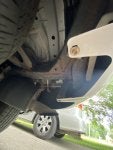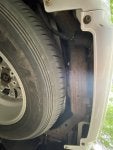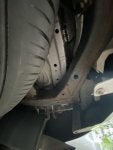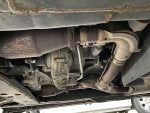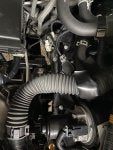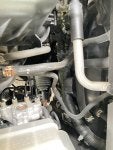Not much of an introduction, but I'll keep it brief. I'm Dylan. I have regularly visited this forum, and the 4x4 Patrol forum, for nearly a year to see people's experiences with the Y62 Armada. I'd like to thank
@twinblown and
@primoV8 and EdBwoy on YouTube for critical pieces of information. I am currently the owner of a 2018 Infiniti Q50 with the VR30DDTT; the engine is quite powerful but a maintenance queen. I do all work on my car by myself as I find it difficult to trust mechanics here in Houston TX. Also the cost savings, lessons, and trove of knowledge and earned tools is amazing. I've been eyeing the Y62 platform ever since it came out in 2010 and am so glad to have the chance to experience them here. I've admired the Y62 chassis for more than half of my life and I still dig it lol. I feel whatever challenges the VR30DDTT has given me has me prepared somewhat for a VK56VD!
I've been doing my best to research issues common and rare for these 2017+ Armadas.
I've compiled a list of issues and would like know what your thoughts are. Am I overthinking a particular issue? Did I miss a big one? etc.
ENGINE
1.
Cylinder Scoring: An issue with VK56VDs produced before March 19, 2019. Possible exacerbated by usage of 0W-20 oil with low octane fuel and extended OCIs. VK56VD pistons only have one oil control ring, and its a pretty thin one; it seems sensitive to oil quality. Can be remedied with frequent (3K-6K mi) oil changes and using something like a good 5W-30/40 oil.
2.
Fan Clutch Fails Closed: Seems to apply to 2021+ Y62 vehicles. Clutch will fail closed cause insane parasitic power loss, fuel economy loss, and NVH increase. Nissan dealerships' only recourse is to replace the clutch with no guarantee of actually fixing the problem. I've seen electric fan conversions for the TA60 chassis Armada, but not explicity for the Y62 Armada. Maybe its possible to do the same?
3.
High Pressure Fuel Pump: A particularly worrisome issue present in all vehicles with the VK56VD. The HPFP develops an internal leak, washing away the oil film between its own lifter bucket and the cammed timing gear. Eventually, enough material is shaved off the cam lobes and bucket so that the oil jets surrounding the timing gears in the RH bank of the engine and the timing chain guides below are damaged. This situation quickly destroys the timing chain system and subsequently the entire engine. Potential recourse is high viscosity oil and regular replacement of the HPFP lifter bucket?
4.
Cracked Exhaust Headers: An issue inherited from the time of VK56DE. Cracks cause an exhaust leak, which causes a number of obvious issues (O2 sensor readings, cabin AC pollution, etc.). Seems like a good opportunity to install long tube headers.
5.
Weak Cat Converter Substrate: Another issue inherited from the time of the VK56DE. The primary cat converters sometimes have a weak substrate that fractures into small pieces of ceramic debris. The exhaust pulsations from the engine can draw in the debris and cause instant catastrophic damage to the engine. Seems like an opportunity for higher flow aftermarket cats and a tune.
6.
Oil Leaks: Leaks from valve cover gaskets, around the oil pressure sensor, behind the alternator and around the oil-coolant heat exchanger. Of course, leaking oil can destroy CV boots, sway bar bushings, and pollute fresh air coming into the cabin.
7.
Starter Motor Conductor: I saw this issue mentioned here. It seems that a conductor going to the starter motor (located under the intake manifold much like a Toyota UZ-series V8) can become frayed from contact with nearby metal and cause a short circuit/zero-resistance condition. Can be remedied with a insulation tape wrapping the conductor.
BODY, ELECTRICAL & SUSPENSION
1.
Rear Air Suspension Sag: Affects older and more thoroughly used Y62s/Z62s. Leaking air bags and lines overwork the air compressor leading to an expensive overhaul. Can this system be removed and converted a coil-over setup?
2.
Gauge Cluster Failure: Seen this a bit on Q50s as well. Sometimes a random gauge reads wrong despite good battery health and alternator output. Unsure of good recourse.
3.
IPDM Current Sensor: A bit of a foolish move from Nissan. Limits alternator loading for short trips, causing much higher load on battery. While the system is good if you go on plenty of longer, 15 + mile trips, its detrimental otherwise. Remedied by simply disconnecting the sensor from the battery in the engine bay.
4.
Brake Light Pedal Switch: Sometimes gets stuck and causes backup collision intervention (BCI) system to freak out among other issues like not starting the engine when pressing the start button, etc. Remedied with a replacement switch and disabling BCI.
5.
HMI Software: Seems to suffer from relaibility issues for some owners. Can crash and brick itself with only recourse being software updates from visits to the the dealership, which I would hate to do.
I didn't explicitly list some of the issues Nissans more premium cars (like this and their other Japan-built offerings) experience (direct injection failure, 7-speed A/T care and issues, front diff sensitivity etc.).
Thanks!



